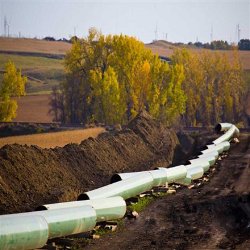At this point in the six-year-long Keystone XL saga, we’re awaiting the final statement regarding potential impact on the environment from the U.S. State Department (which is probably going to emerge within the next few weeks).
After that, there’s a further review to assess whether, overall, the project will serve the best interests of the nation. Finally, after all that is wrapped up, TransCanada Corp. (NYSE: TRP)—the company behind the Keystone XL pipeline—will need at least two years to build the $5.3 billion project, which will link oil production in Alberta, Canada to refineries located along the American Gulf Coast.
 As followers of this drama will remember, TransCanada’s initial submission for the project was rejected due to concerns over potential environmental fall-out from the pipeline’s passage directly through sensitive zones in Nebraska.
As followers of this drama will remember, TransCanada’s initial submission for the project was rejected due to concerns over potential environmental fall-out from the pipeline’s passage directly through sensitive zones in Nebraska.
TransCanada revised its proposal, altering the route, and decided to split up the development in two phases—a southern phase that doesn’t require Presidential approval (already in progress) and the northern phase, which is the part that is awaiting final approval.
The major opposition to the Keystone project comes from environmentalist entities claiming that the lengthy pipeline (spanning almost 2,000 miles) not only raises the likelihood of deadly oil spills, but also that the oil-sands projects in Alberta are actually much more polluting than conventional production options.
This April, Bloomberg reports, TransCanada decided to push its target deadline for completion back into the second half of 2015. The company believes that costs will inevitably rise due to the numerous delays the project has faced thus far. After all, in order to store components already purchased and to keep maintenance going on the built parts of the pipeline, TransCanada is already incurring significant costs.
But Chief Executive Officer of TransCanada Russ Girling is fairly optimistic regarding the outcome of the ongoing Presidential review. Bloomberg quotes:
“There is only one rational decision here,” Girling said. “Denial of this pipeline is not in any way rational. At best, it’s symbolic.”
Recent events may have lent further credibility to Girling’s optimistic stance. After all, if you’re not using pipelines, then you have to use trains as a means of transporting oil. And just recently, Quebec saw a major disaster when a train carrying oil went off-rails and exploded on July 6. Some 50 casualties were noted, to say nothing of the spillage. Certainly, pipelines have a more favorable safety track record.
TransCanada Resists EPA Recommendation
On the other hand, the U.S. Environmental Protection Agency has claimed that TransCanada ought to purchase renewable power sources to run its Keystone pipeline pumps, but the latter has resisted the suggestion citing further cost increases, reports Bloomberg.
The EPA suggested that TransCanada make use of renewable power sources along the route from Alberta to Steele City, Nebraska. Naturally, using renewable power would offset some of the polluting emissions involved with the whole project and its normal functioning.
Our analysts have traveled the world over, dedicated to finding the best and most profitable investments in the global energy markets. All you have to do to join our Energy and Capital investment community is sign up for the daily newsletter below.
According to the EPA, the pipeline will actually have a fairly significant impact on the environment due largely to the scope of the project, as well as the fact that extracting from oil sands is so much more polluting. But TransCanada’s Girling has opted to interpret the point as a political issue, as evident in this quote from Bloomberg:
“I think it’s clear that the Keystone pipeline has no impact on GHG emissions,” Girling said yesterday in an interview at the New York headquarters of Bloomberg News. “What we’re really talking about is Canadian oil versus Venezuelan oil and what is the net difference between the two, and it’s zero.”
It wouldn’t be the first instance of subtle pressure exerted in order to get the Keystone project moving along; Canada’s Stephen Harper publicly underscored the necessity of approving the project during his visit to the U.S. recently.
Nonetheless, U.S. investors have reduced their stakes in oil-sands stocks, Bloomberg reports, in an apparent reaction to the persistent delays plaguing the Keystone project. Companies like Suncor Energy (NYSE: SU) have been affected, and Canadian crude prices remain in a depressed mode.
Over the past three years, Suncor has seen U.S. ownership drop by 8.2 percentage points. If nothing else, it’s an indicator that a lot of investors are anxious to see some movement—either way—on the Keystone project.
If you liked this article, you may also enjoy:



